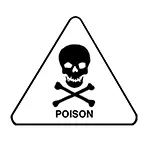
You may know what foods are poisonous to dogs, but what quantities are dangerous?
DISCLAIMER: I am not a veterinarian and have never received formal training in veterinary or human medicine. This article is for informational purposes only. I can’t assume responsibility for any damages to persons or animals by following anything described or referenced in this article. Making the right decision for you and your pet is your responsibility as a dog owner.
You probably have seen lists of products, vegetables, fruits, nuts, or medications toxic to dogs. Knowing what is unsafe for your dog to eat is certainly good. However, what is usually missing is the quantity at which consumption is truly dangerous. For example, if a 5 lb Yorkie eats a raisin or two, that poses a bigger risk than it does for a 150 lb mastiff. For reference, one of my client’s dogs once ate an entire bag of chocolate chip cookies. He was just fine.
This article covers the dangerous quantities of foods and medications toxic to dogs. Further, I will show you how to quickly determine the toxicity level of what your dog consumed. The toxicity level is provided per pound of a dog’s body weight. Consequently, you can easily calculate how much of each substance is dangerous for your dog. In addition, I also share the data sources for each category. I hope you find this information helpful.
In Case of an Emergency
If you think your pet may have ingested a potentially poisonous substance, call for help. The ASPCA Animal Poison Control Center (APCC) is your best resource for any animal poison-related emergency. Hence, they are open 24 hours a day, 365 days a year. Alternatively, you can also call the Pet Helpline Animal Poison Control Center.
ASPCA Animal Poison Control Center: (888) 426-4435 | web
Animal Poison Control Center: (855) 764-7661 | web
Emergency procedures for poisoning usually include inducing vomiting and/or neutralizing the toxin. You can induce vomiting using hydrogen peroxide. Further, food-grade activated charcoal helps neutralize toxins by binding them and preventing absorption. It may be tempting to try these things yourself and, in certain circumstances, possibly be the right decision. However, I highly recommend calling a poison hotline and/or getting your dog to the closest emergency hospital as fast as possible. Because ingesting toxic levels of any substance can result in the death of your pet.
What is Poisonous to Dogs?

GARLIC
Many people believe that garlic in any quantity is poisonous to dogs. That is not so. Too much garlic is. Garlic has a wide range of health benefits for dogs.
Toxicity Level:
Garlic is metabolized in the gastrointestinal tract to highly reactive oxidative metabolites. Ingested garlic can cause hemolysis in dogs.
• Powdered Garlic: dangerous at over 2.3 gram/lb of body weight per day
• Fresh Garlic: dangerous at over ½ clove / 15 lb of body weight per day
A 10 lb dog would need to consume 23 grams of powdered garlic or more than ½ clove of fresh garlic before being in danger.
Is Garlic Poisonous to Dogs?
Garlic got a bad reputation in the year 2000 due to a research paper on the effect of garlic on dogs. The dogs tested didn’t show any outward appearance of toxicity symptoms. However, there was an effect on red blood cells. Hence, the researchers stated: “We believe that foods containing garlic should be avoided for use in dogs.”
Let’s look at the study itself, not just one quote. This study was undertaken at Hokkaido University and was conducted on four dogs. Each dog was given 1.25 ml of garlic extract per kg of body weight for seven days. For example, if the dog weighed 40 pounds, it would be given about 20 garlic cloves. That is a staggering amount! Calculate how much garlic you’d be eating using that formula. It’s enough to make anyone ill.
The study concluded that garlic had the “potential” to cause hemolytic anemia (damage to the red blood cells). Consequently, garlic should not be fed to dogs. It’s important to note that even at these highly elevated doses, no dogs in the study developed hemolytic anemia. In addition, the study included only four dogs, hardly an appropriate sample size. At the very least, it emphasizes the importance of looking at all the facts of any given study.
Source:
• Pet Guide: The Shocking Truth About Dogs and Garlic
• National Institute of Health: Study on the Effects of Garlic on Dogs
Health Benefits of Garlic
- Fighting Infections: Garlic has antimicrobial and antibiotic properties. As a result, it’s beneficial for fighting a wide range of bacterial, fungal, and viral infections.
- Boosting the Immune System: Garlic increases the activity of cells that seek and destroy cancer cells and invading microbes, thus stimulating immune function. As a result, it can help dogs fight cancer or have suppressed immune systems. It also boosts the immune system in healthy dogs. Further, it boosts bloodstream cells that kill bad microbes and cancer cells. (Check out The Complete Guide to Natural Health for Dogs and Cats. This book discusses the benefits of garlic in fighting cancer in dogs).
- Repelling Ticks and Fleas: It won’t kill fleas and ticks, but those little buggers don’t like the taste of it. One sniff, and they’ll be making their way off your dog.
- Boosting Liver Function: Garlic is known to have detoxifying effects, which can help the liver get rid of toxins from the body.
- Fighting Bacterial, Viral, and Fungal Infections: Bacteria, viruses, and fungi are no match for garlic! With its potent antimicrobial and antibiotic properties, it fights parasites and protozoan organisms as well.
- Lowering Blood Cholesterol and Triglyceride: Mix the proper dose of uncooked garlic with your dog’s food. It can help lower blood cholesterol and triglyceride levels.
- Boosting Cardiovascular Function: Wonderful in older and heavier dogs. Garlic can prevent blood clots and reduce cholesterol and fat build-up in the arteries.
Source:

GRAPES AND RAISINS
Grapes and raisins are poisonous to dogs. Ingestion of grapes and raisins (sultanas) can cause severe acute renal failure (grape toxicity). In cases of grape or raisin toxicosis in dogs, the actual mechanism of toxaction remains unknown. The exact pathophysiology of acute renal failure following the ingestion of grapes or raisins remains undetermined. Two theories include metabolic disruption, a nephrotoxic mycotoxin, and an idiosyncratic reaction.
Toxicity Level:
• Grapes: dangerous at 0.7 oz/lb of body weight
• Raisins: dangerous at 0.7 oz/lb of body weight
A 10 lb dog would need to consume 0.7 oz of grapes or raisins before being in danger.
Source: ASPCA Animal Poison Control Center: Grape and Raisin Toxicity in Dogs (PDF)

CHOCOLATE
The toxic component of chocolate is theobromine. Humans easily metabolize theobromine, but dogs process it much more slowly. This allows for a toxic build-up in their system, making chocolate poisonous to dogs. If your dog ingests an amount close to 20 mg/lb of toxic ingredients per pound of body weight, you need to call the vet immediately.
Toxicity Level:
• White Chocolate contains 0.25 mg of theobromine per ounce of chocolate.
• Milk Chocolate contains 58 mg of theobromine per ounce of chocolate.
• Dark Chocolate contains 130 mg of theobromine per ounce of chocolate.
• Baker’s Chocolate contains 393 mg of theobromine per ounce of chocolate.
Example 1: a 20 lb dog consumes 3 oz of dark chocolate.
- How much toxin was consumed? 3 oz * 130 mg = 390 mg toxin
- Calculate mg of toxin per lb of body weight: 390 mg / 20 lb = 19.5 mg/lb
- Assessing the risk: 19.5 is very close to 20. Call the vet immediately.
Example 2: a 20 lb dog consumes 3 oz of milk chocolate.
- How much toxin was consumed? 3 oz * 58 mg = 174 mg toxin
- Calculate mg of toxin per lb of body weight: 174 mg / 20 lb = 8.7 mg/lb
- Assessing the risk: 8.7 is not even remotely close to 20. Low risk.
Even at low risk, your dog may still get an upset stomach or diarrhea, but you won’t have to worry about bringing it to the emergency hospital.

CAFFEINE
Dogs consuming caffeine may have an increased heart rate and become hyperactive. Subsequently, they get jittery and restless and don’t want to lie still. Further, they may pace or vocalize excessively. Caffeine-laden people talk a lot, and their canine counterparts may bark a lot.
Caffeine raises blood pressure and causes cardiac arrhythmias, which can be dangerous. Dogs may also lose muscle control and have tremors or seizures. Caffeine affects the GI tract and causes vomiting. This can be a helpful side effect as it removes toxins from the body. In addition, they may also have diarrhea. Dogs may urinate more, similarly to us, after drinking a couple of sodas.
Dogs with too much caffeine in their system may run a fever and become weak. In severe cases, dogs may collapse or drift into a coma. Finally, some dogs unfortunately die.
Toxicity Level:
• 9 mg caffeine/lb of body weight can lead to symptoms.
• 20 mg caffeine/lb of body weight can lead to severe illness.
• 75-100 mg caffeine/lb of body weight can lead to seizures and death.
A 10 lb dog would only need to consume 90 mg (0.09 gram) of caffeine before being in danger.
Source: Caffeine Toxicity in Pets

ONIONS
Onions contain an ingredient called thiosulphate, poisonous to dogs and cats. The ingestion of onions causes hemolytic anemia, characterized by damage to the red blood cells. Consequently, onion toxicity can cause the red blood cells circulating through your pet’s body to burst.
Onion ingestion commonly leads to liver damage, asthmatic attacks, allergic reactions, weakness, diarrhea, discolored urine, anemia, vomiting, and even dermatitis.
Toxicity Level:
• 0.5% of a dog’s body weight
A 10 lb dog would need to consume 0.5 lb (8 oz) of onion before being in danger.
Source: Onion Poisoning in Dogs

MACADAMIA NUTS
These nuts are very poisonous to dogs! Macadamia nuts can cause weakness, depression, vomiting, tremors, pancreatitis, and hyperthermia in dogs. Signs usually appear within 12 hours of ingestion and can last approximately 12 to 48 hours. Symptoms can include ataxia (walking in a wobbly fashion), lethargy, vomiting, muscle tremors, a raised body temperature, weakness, an elevated heart rate, and more.
Toxicity Level:
• 2.4 gram/kg of body weight
A 10 lb dog would need to consume 10 grams of macadamia nuts before being in danger.
Source: Macadamia Nut Toxicosis in Dogs

OTHER NUTS
Generally, walnuts (English and Japanese), almonds, pecans, peanuts, hickory nuts, pistachios, cashews, and hazelnuts are not poisonous to dogs if they are fresh. But, they are not easily digested. As a result, they can give your dog an upset stomach and create gastric intestinal distress. In addition, pistachios can lead to pancreatitis if fed repeatedly. Also, black walnuts are toxic.
Problems arise with older, moist or moldy nuts. Moldy nuts contain tremorgenic mycotoxins, which can cause seizures or neurological symptoms. Therefore, no amount of moldy nuts or moldy foods are safe for dogs.
In summary, if your dog accidentally eats some fresh nuts (except macadamia nuts or black walnuts, see above), it will most likely get an upset stomach but otherwise, be ok. If your dog eats moldy nuts, call your veterinarian.

ALCOHOL
Alcohol toxicosis results in metabolic acidosis, hypothermia, and CNS depression. CNS depression refers to physiological depression of the central nervous system that consequently can result in a decreased rate of breathing, reduced heart rate, and loss of consciousness. Finally, it can lead to coma or death. In short, alcohol is quite poisonous to dogs.
Toxicity Level:
• 2-4 ml/lb of body weight
Example: a 10 lb dog consumes 2 fl oz of beer with 4.2% alcohol (i.e., Budweiser).
- The dog consumed 2 (fl oz) * 29.5735 = 59.15 ml of beer.
- That amount of beer has 59.15 ml * 4.2% = 2.48 ml of alcohol.
- A 10 lb dog would be at risk at 2ml * 10 lb = 20 ml of alcohol consumption.
- Assessing the risk: 2.48 ml is way below 20 ml. Minimal to no risk.
A 10 lb dog would need to consume 20 to 40 ml of alcohol before being in danger.

XYLITOL
(in many sugar-free gums and candy)
Xylitol is a naturally occurring substance widely used as a sugar substitute. Chemically, it is a sugar alcohol, and in nature, it is found in berries, plums, corn, oats, mushrooms, lettuce, trees, and some other hardwood trees and fruits.
Commercially, most xylitol is extracted from corn fiber, birch, hardwood, and other vegetable material. Although it has been used as a sugar substitute for decades, its popularity has increased dramatically in the last few years.
However, xylitol is extremely poisonous to dogs. Even small amounts of xylitol can cause hypoglycemia (low blood sugar), seizures, liver failure, or even death in dogs. Xylitol is estimated to be 100 times as toxic as chocolate to dogs. Sugar-free gum is the most common source of xylitol poisoning the Pet Poison Helpline gets called about. With certain brands of gum, only 9 pieces of gum can result in severe hypoglycemia in a 45-pound dog, while 45 pieces would need to be ingested to result in liver failure.
With other common brands of gum (which contain 1 g/piece of gum), only 2 pieces would result in severe hypoglycemia, while 10 pieces can result in liver failure. As there is a large range of xylitol in each different brand and flavor of gum, it is important to identify whether a toxic amount has been ingested.
More recently, veterinarians started warning pet owners of peanut butter; some brands now use xylitol as a sweetener. Make sure to check the label if you buy peanut butter.
Toxicity Level:
• 50 mg/lb of body weight can lead to hypoglycemia.
• 225mg/lb of body weight can lead to liver failure.
A 10 lb dog would only need to consume 500 mg (0.5 gram) of xylitol before being in danger.
Source: Xylitol Poisoning in Dogs

NEVER SAFE
No amount of the following is safe for your dog. Call your veterinarian immediately should your dog ingest any of these:
• Unbaked bread dough
• Compost
• Human medications
• Household cleaners

ACTUALLY HARMLESS
Despite popular belief, the following are harmless to your dog. The worst you’ll see is an upset stomach for a day or two:
• Tomato (ripe)
• Avocado
The reason avocados are often listed as dangerous is the seed. A dog could choke on it. The flesh of an avocado is harmless.

IBUPROFEN
(Advil and Motrin)
Ibuprofen is a non-steroidal, anti-inflammatory drug (NSAID) and the active ingredient in Advil and Motrin.
Toxicity Level:
(1 lb = 0.453592 kg)
• 25-125 mg/kg leads to vomiting, diarrhea, nausea, abdominal pain, anorexia
• > 175 mg/kg leads to all the above plus hematemesis, melena, polyuria or polydipsia, oliguria, uremia, acute renal failure
• > 400 mg/kg leads to all the above plus seizures, ataxia, coma, shock
• > 600 mg/kg leads to death
A 10 lb dog would only need to consume 10 lb * 0.453592 kg * 25 mg = 113 mg (0.11 gram or 0.0038 oz) to be in danger.
Induce vomiting if possible. Seek veterinary attention immediately. The emergency response your veterinarian will most likely take is administering activated charcoal every six to eight hours for 24 hours or pumping out the stomach if it’s not too late.
Source: Ibuprofen Toxicity in Dogs

NAPROXEN
(Aleve, Anaprox, Naprosyn, Apranax and Naprelan)
Naproxen is a non-steroidal, anti-inflammatory drug (NSAID) structurally and pharmacologically similar to ibuprofen and ketoprofen. Naproxen is the active ingredient in Aleve, Anaprox, Naprosyn, Apranax, Naprelan and Apo-naproxen.
Toxicity Level:
(1 lb = 0.453592 kg)
• 2-10 mg/kg of body weight may result in gastrointestinal irritation or ulceration
• > 10 mg/kg of body weight may put dogs at risk for acute renal failure
A 10 lb dog would only need to consume 10 lb * 0.453592 kg * 2 mg = 9.07 mg (0.009 gram or 0.00032 oz) to be in danger.
Induce vomiting if possible. Seek veterinary attention immediately. The emergency response your veterinarian will most likely take is administering activated charcoal every six to eight hours for 24 hours or pumping out the stomach if it’s not too late.
Source: Naproxen Toxicity in Dogs

ACETAMINOPHEN
(Tylenol, Excedrin, Allerest, Anacin-3, Comtrex, Dayquil, Nyquil, SineAid, SineOff, Vanquish)
In the body, acetaminophen is changed into glucuronic acid and sulfate. A small amount is normally oxidized to reactive metabolites. These reactive compounds are normally bound by glutathione and excreted from the body. At elevated doses, the supply of glutathione becomes exhausted allowing the reactive metabolite to bind to cells causing cell death. Acetaminophen is very poisonous to dogs.
Toxicity Level:
• 45 mg/lb of body weight
A 10 lb dog would only need to consume 450 mg of Acetaminophen to be in danger.
Induce vomiting if possible. Seek veterinary attention immediately. The emergency response your veterinarian will most likely take is administering activated charcoal every six to eight hours for 24 hours or pumping out the stomach if it’s not too late.
Source: Acetaminophen Toxicity in Dogs

ASPIRIN
(Acetylsalicylic Acid, and Salicylate)
The toxic effects include bone marrow suppression, bleeding, liver inflammation, kidney disease, and stomach ulceration. Signs usually develop within 4-6 hours with an acute overdose. They include depression, lack of appetite, vomiting, which may contain blood, abdominal pain, increased respiratory rate, acute kidney failure, weakness, coma, and death. Aspirin is poisonous to dogs.
Toxicity Level:
• 45 mg/lb of body weight per day
• Chronic lower doses in dogs may still lead to stomach ulcers and perforation, toxic liver inflammation, and bone marrow suppression resulting in anemia.
A 10 lb dog would only need to consume 450 mg of Aspirin to be in danger.
Induce vomiting if possible. Seek veterinary attention immediately. The emergency response your veterinarian will most likely take is administering activated charcoal every six to eight hours for 24 hours or pumping out the stomach if it’s not too late.
Source: Aspirin Toxicity in Dogs

ZOLOFT
(Sertraline)
Zoloft, also called Sertraline, is a commonly prescribed drug for depression in people. An overdose of Zoloft in dogs can cause vomiting, diarrhea, increased salivation, and lethargy. If dogs eat too much Zoloft, they can get more serious symptoms such as muscle tremors, agitation, hyperactivity, more vocalizing, high or low blood pressure, seizures, and coma. Also, it can be fatal. These more serious symptoms can be caused by something called serotonin syndrome.
Toxicity Level:
(1 lb = 0.453592 kg)
• 10-20 mg/kg of body weight can lead to mydriasis
• 30-50 mg/kg of body weight can lead to muscle tremors
• 80 mg/kg of body weight can lead to death
A 10 lb dog would only need to consume 10 lb * 0.453592 kg * 10 mg = 45 mg to be in danger.
Source: Antidepressant Drug Overdoses in Dogs (PDF)

CYMBALTA
(Duloxetine)
Duloxetine is prescribed as an antidepressant and anti-anxiety agent for people. When ingested by pets it can cause agitation, vocalization, tremors, and seizures. It is poisonous to dogs.
Toxicity Level:
(1 lb = 0.453592 kg)
• 1.5 – 12 mg/kg of body weight
A 10 lb dog would only need to consume 10 lb * 0.453592 kg * 1.5 mg = 7 mg to be in danger.

EFFEXOR
(Venlafaxine hydrochloride)
Venlafaxine is a potent inhibitor of neuronal serotonin and norepinephrine reuptake and a weak inhibitor of dopamine reuptake. It’s well-absorbed and not highly protein-bound. The half-life in dogs is two to four hours.
Toxicity Level:
(1 lb = 0.453592 kg)
• 1 mg/kg of body weight can lead to mild depression
• 10 mg/kg of body weight can lead to tremors
A 10 lb dog would only need to consume 10 lb * 0.453592 kg * 1 mg = 4.5 mg to be in danger.
Source: Antidepressant Drug Overdoses in Dogs (PDF)




